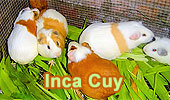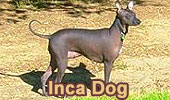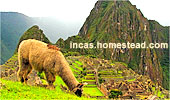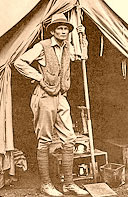|
Hiram Bingham, the American explorer who found the
ruins of Machu Picchu in 1911, wrote:
Not only were the Incas remarkable for
domesticating plants, they also showed great skill in domesticating
animals. In the Andes is a little rodent, called cuy. It is
extremely timid and difficult to catch. We call it a guinea pig although
it never came from Guinea and is not a pig. Discovering that it was very
palatable when roasted over an open fire or boiled in a stew the Incas
domesticated it and developed a dozen different varieties, all of which
are so tame that they can be trusted to run about the floor of an escape
and are ready to be caught, killed, cooked and served as delicious
morsel whenever company appears unexpectedly.

Father Cobo, a learned Jesuit, who traveled
extensively in the Andes in 1600, tells how guinea pigs were cooked in
his day. In preparing a stew, red pepper was added, also smooth little
pebbles from the river! These were placed in the belly of the cuy after
being thoroughly heated, so as to hasten the process of cooking. He
states with praiseworthy candor, "this dish is more esteemed by the
Indians than any of the more delicate ones which Spaniards make. The
flesh of the domesticated kind is more delicate. The three wild kinds
are somewhat smaller than domesticated and are found in great numbers in
the fields."
The Incas domesticated at least three
varieties of dogs but there is no evidence that, like the Polynesians,
they used any of them as an article of food.

Another interesting product of Inca skill at
breeding animals has to do with the native American camel, known as the
guanaco. Not so very long ago vast herds of guanaco were still to
be found in Patagonia where they enjoy a climate very similar to the
highlands of Peru. These little camels measure more than six feet and
sometimes as much as seven feet to the top of the head. Guanaco
hunting used to be regarded as the finest sport in South America. They
are exceedingly shy and it requires no little patience to get within gun
shot of them.
Although guanacos are all of one color, the
llamas and alpacas that were developed from the little native camels are
of many different colors. Furthermore, the Incas actually succeeded in
the difficult and tedious process of breeding the little camels into two
varieties for entirely different purposes. One the llama, is streamlined
and well adapted to act as a beast of burden even though it is neither
large enough nor strong enough to carry more than ninety or a hundred
pounds. It has legs fairly free from wool and its hair is coarse and
able to stand the chafing caused by the loads they carry. On the other
hand, the alpaca, descended from the same ancestor as the llama, is
conspicuously wooly, both as to its legs and neck. Its hair is fine and
soft and it welcomed in modern commerce as one of the most desirable
materials, obtainable for making luxurious woolen garments. Due to the
fact that shrewd cloth merchants, many year ago, adopted the name
"alpaca" for a rather coarse material made from sheep's wool and cotton
and used extensively in the manufacture of thin black coats, the term
"alpaca" is not used in commerce to designate the real article.
Overcoats and shawls made of the beautiful soft wool of the Peruvian
alpaca are usually said to be "camel's hair," "vicuna" or even
"llama!" Few purchasers in the Northern Hemisphere know that llama wool
is too coarse to be desirable for such purposes. On the other hand, if
the material were called "alpaca" the purchaser would not expect it to
be any softer or more attractive than the ancient product of Yankee
ingenuity.

It is interesting to note that the Incas and
their influence throughout the Andes apparently did not extend any
further north than the known limits of the llama. In fact, the
development of their culture may be said to have depended in large
measure on their success in domesticating this little American camel.
Their ability to raise and train hundreds of thousands of llamas which
could and would carry useful loads enabled the mountain people to carry
out engineering and agricultural works far more extensive than could
have been accomplished had they been obliged to depend entirely on human
burden-bearers.
Source:
‘Lost City of the Incas, The Story of Machu
Picchu and its Builders’ by Hiram Bingham
The American explorer who found the ruins of Machu Picchu in 1911.

Hiram Bingham at Machu Picchu
The inspiration for Indiana Jones?
|